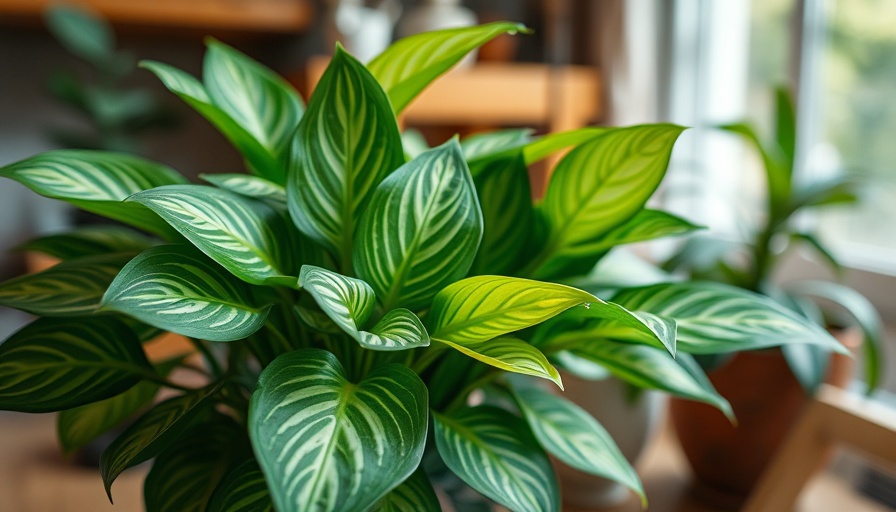
Embrace the Café Core Aesthetic in Your Home
If you’ve ever stepped into your favorite coffee shop and felt the warm embrace of its atmosphere, you know how vital plants are in crafting that cozy environment. Café core is more than just a design trend—it's about invoking feelings of comfort and connection in your personal space. By integrating specific houseplants that flourish in a variety of settings, you can easily transform your home into a relaxing sanctuary reminiscent of that inviting café ambiance.
Key Houseplants for Creating Cozy Vibes
The charm of houseplants goes beyond aesthetics; they bring life and energy into your home. Here are some essential café core plants that elevate your interiors:
Pothos: The Elegance of Simplicity
Pothos plants are the quintessential café core houseplant. With their cascading vines and heart-shaped leaves, they add an effortless elegance that can transform any space. This low-maintenance beauty thrives in various lighting conditions, making it perfect for busy homeowners. You can style them by letting their vines drape over shelves or hang from baskets, providing both verticality and lushness.
Monstera: Bringing the Tropics Indoors
The Monstera deliciosa, known for its striking fenestrated leaves, adds a bold, tropical flair to your home decor. It serves not just as a decorative piece but also as an air purifier, improving your indoor environment as it beautifies it. Grouping a monstera with wooden accents or vintage finds can enhance that cozy café essence that encourages leisurely sips of coffee as you unwind.
Snake Plant: Stylish and Resilient
The snake plant, known for its upright growth and sculptural leaves, is a stylish addition to any room. Beyond its aesthetic appeal, it ranks high as one of the best air-purifying houseplants. Its ability to thrive in low-light settings makes it a great choice for bedrooms or corners that need a touch of greenery without demanding much upkeep.
Peace Lily: Classic Charm Meets Elegance
The peace lily stands out with its lush green foliage and pristine white blooms, perfectly fitting into the café core aesthetics. Not only does it require minimal care, but it also thrives in lower light, making it an ideal choice for homes that don’t boast abundant sun. Its soothing presence brings a serene and polished touch to your café-inspired space.
ZZ Plant: Champion of Resilience
If you're new to indoor gardening or prefer an easygoing plant, the ZZ plant is your best friend. This resilient houseplant adds a glossy elegance to your interiors and requires very little water. Its versatility allows it to adapt to various home settings, aligning perfectly with the relaxed vibe of café core aesthetics.
Calathea: Artistry in Plant Form
For those who appreciate unique patterns in plants, the calathea brings artistry into your home with its striking foliage. These plants not only provide texture and visual interest, but they also prefer humidity—making them perfect for bathrooms or kitchens. By adding a calathea, you bring both beauty and freshness to your interior, enhancing the overall ambiance.
Integrating Houseplants into Your Design
When decorating with these café core houseplants, consider placement carefully. Grouping various plants according to their light needs while creating distinct vignettes throughout your space can enhance the inviting ambiance. Soft, ambient lighting alongside your houseplants can create beautiful shadows, giving your living areas a relaxed and cozy cafe-like atmosphere.
A Wrapping Idea: Crafting Your Personal Oasis
As you infuse your home with these essential plants, remember that creating a cozy café vibe is about more than just aesthetics. It’s about curating an environment that fosters connection, relaxation, and comfort. Consider taking a moment each day to enjoy your plants, whether it’s watering them or simply appreciating their beauty. This intentional act can transform mundane moments into something special.
Conclusion: Your Gateway to a Cozy Home Experience
Transform your living space into a botanical escape filled with personality, warmth, and relaxation by incorporating these café core houseplants. With their various styles and low-maintenance needs, these plants ensure you'll create an inviting atmosphere that welcomes both friends and cherished solitary moments alike. So, gather your pots, choose your plants, and embrace the delightful journey of home gardening!
For more home improvement tips and ideas, explore professional insights and design inspiration that will help raise the bar in your personal projects.
 Add Row
Add Row  Add
Add 




Write A Comment